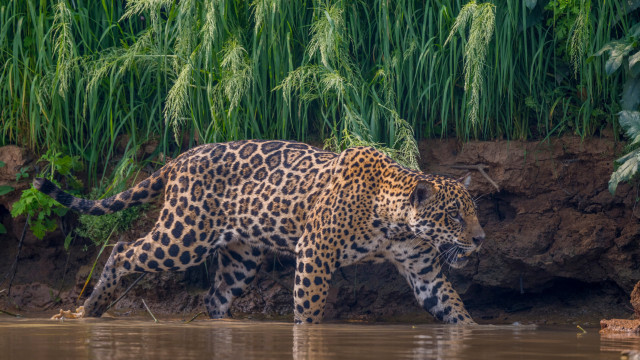



























© Shutterstock
0 / 28 Fotos
A long time ago
- Dinosaurs lived in a stretch of time known as the Mesozoic era, which occurred from about 230 million years ago until about 60 million years ago. During this time, many dinosaurs of varying sizes roamed the planet.
© iStock
1 / 28 Fotos
Bird of a feather
- The smallest known (and also the smallest living) dinosaur in all of history is the hummingbird. This contrasts massively to theropods, a group of reptiles that includes famous species like the Tyrannosaurus rex.
© Shutterstock
2 / 28 Fotos
Fossilized records
- While scientists can never be truly certain about which dinosaurs were the biggest, some of their fossils have provided a bit of insight into what the world was like back then, and what contributed to their massive size.
© Getty Images
3 / 28 Fotos
Biggest and baddest
- Dinosaurs, particularly titanosaurs like Argentinosaurus (pictured), were the largest known land animals to have ever existed, and even surpassed modern giants like the blue whale in size. These creatures weighed up to 63 tons (57 tonnes) and reached lengths of around 123 feet (37.5 m).
© Shutterstock
4 / 28 Fotos
Stomachs and size
- Titanosaurs in particular also had unique features, including wide hips, which provided stability and space for their large stomachs. This enabled them to consume and digest large amounts of food, which was crucial for sustaining their massive bodies and helped them grow.
© Shutterstock
5 / 28 Fotos
Theropods
- Most two-legged carnivorous dinosaurs (known as theropods) reached a peak size due to biomechanical constraints, which indicates that there is an upper limit to how big two-legged animals can get. This suggests that four-legged dinosaurs (sauropods) had an advantage in growing larger.
© Shutterstock
6 / 28 Fotos
Sauropods
- Sauropods are a sub-group of titanosaurs (which includes Argentinosaurus), and they achieved gigantism through a combination of physiological and ecological adaptations, such as long necks for reaching high vegetation and efficient respiratory systems.
© Shutterstock
7 / 28 Fotos
Bone structure
- Sauropods had a unique bone structure with air-filled cavities, similar to modern birds. This adaptation made their bones lighter, reducing the energy needed to move their massive bodies and allowing them to grow bigger.
© Shutterstock
8 / 28 Fotos
Oxygen
- Dinosaurs (particularly sauropods) had bird-like breathing systems, which included air sacs in their bones, that allowed them to take in oxygen continuously, even while exhaling. This facilitated their large size by ensuring efficient oxygen supply.
© Shutterstock
9 / 28 Fotos
Reproduction
- Dinosaurs also laid numerous eggs to increase the likelihood that offspring would survive. Over generations, this survival contributed to the evolution of larger species.
© Shutterstock
10 / 28 Fotos
Predators
- Another reason why dinosaurs grew so large is because gigantism was actually a great defense mechanism against predators. Larger dinosaurs were more formidable and less likely to be preyed upon, which increased their chances of survival and reproduction.
© Shutterstock
11 / 28 Fotos
Feeding
- Large herbivores could feed more efficiently by accessing high vegetation and processing large amounts of food in their extensive digestive systems. This efficiency allowed them to sustain their enormous sizes.
© Getty Images
12 / 28 Fotos
Necks
- The long necks of sauropods also allowed them to feed over a wide area without moving much, which conserved energy and encouraged their growth.
© Shutterstock
13 / 28 Fotos
Climate and vegetation
- Warm climates and abundant vegetation during the Mesozoic era provided the necessary resources to allow large populations of gigantic dinosaurs to thrive, considering they had access to plentiful food sources almost year round.
© Shutterstock
14 / 28 Fotos
Seasons
- Paleontologists have suggested that seasonal fluctuations in the availability of resources may have influenced the evolution of large body sizes in dinosaurs. These reptiles stored energy during times of abundance (which added to their size) so that they were biologically prepared for when resources became scarce.
© Shutterstock
15 / 28 Fotos
Bigger isn't always better
- Although titanosaurs were very energy efficient and could withstand stretches of food scarcity, if such periods lasted too long, they would face significant challenges. Larger animals require more sustenance than smaller ones, so extended periods without adequate resources often jeopardized their survival.
© Shutterstock
16 / 28 Fotos
Social behavior
- Herding behavior in some dinosaur species could have supported the evolution of large body sizes. By being in a herd, dinosaurs were more protected against predators, and so they were able to acquire resources and food more easily.
© Shutterstock
17 / 28 Fotos
Not a picky eater
- Not only was food in abundance during many periods of the Mesozoic era, sauropods also had the ability to consume a diverse range of existing vegetation, including tough-to-digest plants, which gave them a dietary advantage and contributed to their ability to sustain large populations across various habitats.
© Shutterstock
18 / 28 Fotos
Metabolism
- Sauropods had a highly efficient metabolism that slowed down as they grew older, which reduced the amount of food they needed to get energy. This allowed them to thrive on less food compared to mammals of similar sizes.
© Shutterstock
19 / 28 Fotos
Predator and prey
- One important factor to consider is the relationship that predators and prey have in the wild. As prey species grew larger, dinosaur predators needed to evolve to larger sizes as well to successfully hunt them. This, in turn, caused prey to grow larger so that they could withstand predation, which caused a continuous cycle of predator-prey growth.
© Getty Images
20 / 28 Fotos
Plant evolution
- Much like the predator-prey coevolution, herbivorous dinosaurs and their gigantism may have influenced the evolution of plants as well, leading to larger and more nutritious vegetation. This mutualistic relationship benefited both the dinosaurs and the plant species they fed on.
© Shutterstock
21 / 28 Fotos
Extinction events
- Throughout history, certain extinction events may have removed competitive predator species, which allowed surviving dinosaurs to grow larger. After these events, the absence of competitors provided opportunities for survivors to exploit new ecosystems and resources.
© Reuters
22 / 28 Fotos
Mating
- Large body sizes in some dinosaurs could have been the result of sexual selection, where bigger size was favored for mating purposes. Larger males might have been more attractive to females, which led to the evolution of larger sizes.
© Shutterstock
23 / 28 Fotos
Environment
- Interestingly, there are some environmental factors that influenced how big dinosaurs became. Volcanic activity, climate change, and sea levels influenced dinosaur evolution, since these factors created diverse habitats that supported the growth of large species.
© Reuters
24 / 28 Fotos
Sauropod plateau
- During the Late Jurassic period, sauropods reached a size plateau and maintained constant gigantism afterward. Studies have suggested that they had optimized their size for their ecological roles and had no need to grow bigger.
© Shutterstock
25 / 28 Fotos
Other reptiles - So why don’t reptiles grow to the size of dinosaurs anymore? Unlike the upright, pillar-like stance of dinosaurs, modern-day reptiles have a more sprawling stance that is less efficient for supporting large bodies. This sprawling stance uses more energy to move and support weight.
© Shutterstock
26 / 28 Fotos
Research
- The fossil record of dinosaurs provides a rich source of data that allows paleontologists to study how animals have evolved, as well as how changes to the environment and climate can affect creatures across millions of years. This research will most likely never cease. Sources: (Natural History Museum) (National Geographic) (The Guardian) (Science World) (Discover Magazine) See also: 166-million-year-old dinosaur footprints discovered in the UK
© Shutterstock
27 / 28 Fotos
© Shutterstock
0 / 28 Fotos
A long time ago
- Dinosaurs lived in a stretch of time known as the Mesozoic era, which occurred from about 230 million years ago until about 60 million years ago. During this time, many dinosaurs of varying sizes roamed the planet.
© iStock
1 / 28 Fotos
Bird of a feather
- The smallest known (and also the smallest living) dinosaur in all of history is the hummingbird. This contrasts massively to theropods, a group of reptiles that includes famous species like the Tyrannosaurus rex.
© Shutterstock
2 / 28 Fotos
Fossilized records
- While scientists can never be truly certain about which dinosaurs were the biggest, some of their fossils have provided a bit of insight into what the world was like back then, and what contributed to their massive size.
© Getty Images
3 / 28 Fotos
Biggest and baddest
- Dinosaurs, particularly titanosaurs like Argentinosaurus (pictured), were the largest known land animals to have ever existed, and even surpassed modern giants like the blue whale in size. These creatures weighed up to 63 tons (57 tonnes) and reached lengths of around 123 feet (37.5 m).
© Shutterstock
4 / 28 Fotos
Stomachs and size
- Titanosaurs in particular also had unique features, including wide hips, which provided stability and space for their large stomachs. This enabled them to consume and digest large amounts of food, which was crucial for sustaining their massive bodies and helped them grow.
© Shutterstock
5 / 28 Fotos
Theropods
- Most two-legged carnivorous dinosaurs (known as theropods) reached a peak size due to biomechanical constraints, which indicates that there is an upper limit to how big two-legged animals can get. This suggests that four-legged dinosaurs (sauropods) had an advantage in growing larger.
© Shutterstock
6 / 28 Fotos
Sauropods
- Sauropods are a sub-group of titanosaurs (which includes Argentinosaurus), and they achieved gigantism through a combination of physiological and ecological adaptations, such as long necks for reaching high vegetation and efficient respiratory systems.
© Shutterstock
7 / 28 Fotos
Bone structure
- Sauropods had a unique bone structure with air-filled cavities, similar to modern birds. This adaptation made their bones lighter, reducing the energy needed to move their massive bodies and allowing them to grow bigger.
© Shutterstock
8 / 28 Fotos
Oxygen
- Dinosaurs (particularly sauropods) had bird-like breathing systems, which included air sacs in their bones, that allowed them to take in oxygen continuously, even while exhaling. This facilitated their large size by ensuring efficient oxygen supply.
© Shutterstock
9 / 28 Fotos
Reproduction
- Dinosaurs also laid numerous eggs to increase the likelihood that offspring would survive. Over generations, this survival contributed to the evolution of larger species.
© Shutterstock
10 / 28 Fotos
Predators
- Another reason why dinosaurs grew so large is because gigantism was actually a great defense mechanism against predators. Larger dinosaurs were more formidable and less likely to be preyed upon, which increased their chances of survival and reproduction.
© Shutterstock
11 / 28 Fotos
Feeding
- Large herbivores could feed more efficiently by accessing high vegetation and processing large amounts of food in their extensive digestive systems. This efficiency allowed them to sustain their enormous sizes.
© Getty Images
12 / 28 Fotos
Necks
- The long necks of sauropods also allowed them to feed over a wide area without moving much, which conserved energy and encouraged their growth.
© Shutterstock
13 / 28 Fotos
Climate and vegetation
- Warm climates and abundant vegetation during the Mesozoic era provided the necessary resources to allow large populations of gigantic dinosaurs to thrive, considering they had access to plentiful food sources almost year round.
© Shutterstock
14 / 28 Fotos
Seasons
- Paleontologists have suggested that seasonal fluctuations in the availability of resources may have influenced the evolution of large body sizes in dinosaurs. These reptiles stored energy during times of abundance (which added to their size) so that they were biologically prepared for when resources became scarce.
© Shutterstock
15 / 28 Fotos
Bigger isn't always better
- Although titanosaurs were very energy efficient and could withstand stretches of food scarcity, if such periods lasted too long, they would face significant challenges. Larger animals require more sustenance than smaller ones, so extended periods without adequate resources often jeopardized their survival.
© Shutterstock
16 / 28 Fotos
Social behavior
- Herding behavior in some dinosaur species could have supported the evolution of large body sizes. By being in a herd, dinosaurs were more protected against predators, and so they were able to acquire resources and food more easily.
© Shutterstock
17 / 28 Fotos
Not a picky eater
- Not only was food in abundance during many periods of the Mesozoic era, sauropods also had the ability to consume a diverse range of existing vegetation, including tough-to-digest plants, which gave them a dietary advantage and contributed to their ability to sustain large populations across various habitats.
© Shutterstock
18 / 28 Fotos
Metabolism
- Sauropods had a highly efficient metabolism that slowed down as they grew older, which reduced the amount of food they needed to get energy. This allowed them to thrive on less food compared to mammals of similar sizes.
© Shutterstock
19 / 28 Fotos
Predator and prey
- One important factor to consider is the relationship that predators and prey have in the wild. As prey species grew larger, dinosaur predators needed to evolve to larger sizes as well to successfully hunt them. This, in turn, caused prey to grow larger so that they could withstand predation, which caused a continuous cycle of predator-prey growth.
© Getty Images
20 / 28 Fotos
Plant evolution
- Much like the predator-prey coevolution, herbivorous dinosaurs and their gigantism may have influenced the evolution of plants as well, leading to larger and more nutritious vegetation. This mutualistic relationship benefited both the dinosaurs and the plant species they fed on.
© Shutterstock
21 / 28 Fotos
Extinction events
- Throughout history, certain extinction events may have removed competitive predator species, which allowed surviving dinosaurs to grow larger. After these events, the absence of competitors provided opportunities for survivors to exploit new ecosystems and resources.
© Reuters
22 / 28 Fotos
Mating
- Large body sizes in some dinosaurs could have been the result of sexual selection, where bigger size was favored for mating purposes. Larger males might have been more attractive to females, which led to the evolution of larger sizes.
© Shutterstock
23 / 28 Fotos
Environment
- Interestingly, there are some environmental factors that influenced how big dinosaurs became. Volcanic activity, climate change, and sea levels influenced dinosaur evolution, since these factors created diverse habitats that supported the growth of large species.
© Reuters
24 / 28 Fotos
Sauropod plateau
- During the Late Jurassic period, sauropods reached a size plateau and maintained constant gigantism afterward. Studies have suggested that they had optimized their size for their ecological roles and had no need to grow bigger.
© Shutterstock
25 / 28 Fotos
Other reptiles - So why don’t reptiles grow to the size of dinosaurs anymore? Unlike the upright, pillar-like stance of dinosaurs, modern-day reptiles have a more sprawling stance that is less efficient for supporting large bodies. This sprawling stance uses more energy to move and support weight.
© Shutterstock
26 / 28 Fotos
Research
- The fossil record of dinosaurs provides a rich source of data that allows paleontologists to study how animals have evolved, as well as how changes to the environment and climate can affect creatures across millions of years. This research will most likely never cease. Sources: (Natural History Museum) (National Geographic) (The Guardian) (Science World) (Discover Magazine) See also: 166-million-year-old dinosaur footprints discovered in the UK
© Shutterstock
27 / 28 Fotos
How did dinosaurs grow so big?
Some of the biggest animals on Earth lived millions of years ago
© Shutterstock
Dinosaurs are reptiles that lived in what is known as the Mesozoic era, and their bones can be seen in almost every natural history museum in the world. And for good reason: they were discovered in the 18th century and have since dominated the natural world with their interesting history and their massive size.
But how did they grow so big? And why have there been no other species that could match their size? Click through the following gallery to find all those answers and more.
RECOMMENDED FOR YOU




































MOST READ
- Last Hour
- Last Day
- Last Week








